Your body language provides an immediate signal of our feelings and intentions towards another person or situation. However, most people are either unaware or unconscious of the body messages we send to others. Sadly, the receivers of your message will make a snap judgement based on your body language alone. That is why is very essential for us to learn body language so as to be effectively relate to people well, in a way that fosters trust and mutual understanding.
According to University of California professor Albert Mehrabian, your words communicate about 7% of who you are. Your tone of voice accounts for 38% of your communication while the rest, about 55% can be inferred from your body language.
Understand the neuroscience behind body language
When someone walks towards you, seated next to you or in front of you, your brain invokes the mirror neurons which are biologically programmed to quickly assess if:
- The person is emotionally okay- are they sad, mad or happy?
- The person is more powerful than us.
- The person is a potential threat
Your brain assesses the other person by relating to the behaviour you observe stored in your database of feelings and experiences. Then your brain makes a guesstimate on the feelings, power, strengths and intentions of the other person and prepares your body for reaction. The brain will do that by relaying the right message (flight or fight) to the relevant glands. The glands produce the hormones which give or deprive your body of the energy it needs to react accordingly.
Your body posture – how powerful is it?
Our behaviors and emotions are firmly tied. In most occasions, we are not aware that we are sending the wrong body message. We pick up habits, such as walking into a meeting and sitting down with our shoulders slumped, and we don’t even think about it. Your body posture has a physiological effect in your body. Your body posture affects your body chemistry which in turns shapes your feelings and reactions to different situations.
In her research, Amy Cuddy, a social Psychologist, a specialist on body language and its impacts on hormones demonstrated that non-verbal gestures, expressions and behavior affect the way the person feels about his own position, competence and mood. She also mentions in her research that it is possible to modify perceptions of others about you as well as your own body chemistry, just by changing your body positions.
Low-Power poses

Do you often hunch over a newspaper, your Smartphone while talking to your friends or colleagues? Do you occasionally grab arms, toss your hair, touch your nose or neck while in a group of people or before your boss? Do you try to make yourself too small or invisible while in a group of people? These are signs of insecurity or anxiety. You are in other words low-posing.
High-power poses
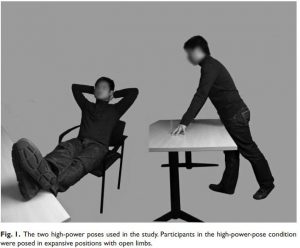
Have you ever observed how animals behave when they want to protect their turfs and set up boundaries? Animals puff up to appear bigger. Not surprisingly, humans do the same thing. This is a power pose associated with marking your territory or getting aggressive. It is the dominant body language. It is language meant to intimidate your opponents, using particular body poses. To achieve this, you need to sit, lie or stand in a way that opens up your exposed areas –throat, solar plexus, underarms – as an indication that you aren’t threatened by the other party. However, you should be careful when practicing high-power poses to avoid triggering signals of vulnerability by trying to reassert dominance.
Your body’s cortisol levels and high power poses
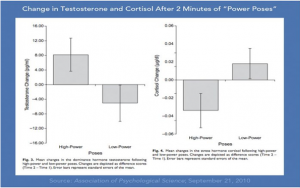
Your nonverbal gestures, expressions and behavior effect the secretion of vital hormones –testosterone, associated with dominance and cortisol, a stress hormone. According to studies sponsored by Oregon and Harvard universities, assuming power poses leads to production of high levels of testosterone and low cortisol. Such people tend to be more confident, authoritative, assertive and relaxed. Whereas, people in low power role have low levels of testosterone and high levels of cortisol and tend to be nervous and subjective in their reactions.
To prove that point, Dr. Amy used 42 randomly selected participants to complete high or low power poses for two minutes each. After the tests, she noted that high power poses had higher testosterone levels and lower cortisol levels. Interestingly, after two 2 minutes of power posing, the participants reported feeling more powerful, ready to gamble and take risk. Now, you know it is easy for you to understand and modify your body language. You can then control secretion of these hormones, increase testosterone and decrease cortisol. Thus, take it as your personal challenge to make yourself feel better, more confident and risk tolerant, just by changing your body posture.
Power poses and your performance
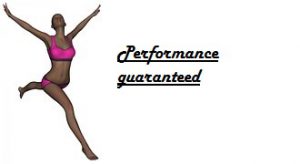
Studies have shown that elevated cortisol is associated with poor cognitive function in our bodies. For us to perform better, we need to invoke our psychological power. The psychological power enhances executive function in our bodies, which is critical to our ability to effectively plan and prepare for challenging situations. Practicing a “power pose” for a few minutes on a daily basis leads to higher levels of testosterone and lower levels of the stress hormone, cortisol. These physiological changes are linked to better performance and more confident and assertive behavior.
So, if you’re feeling stressed a few minutes before a certain ‘frightening’ activity- delivering a speech, meeting new friends, performing before a large crowd — take a moment to adjust your posture and stand in a powerful position. Put your hands on your hips, keep your chin up, and your chest out. Doing this for just two minutes will raise your testosterone and increase your confidence, while also decreasing your cortisol and improving your ability to handle stress. A research done by Dr. Briñol and his colleagues concluded that that power posing does increase self-confidence, but only amongst those who had positive self-thoughts. On others, it had an opposite effect.
It is a little tricky with women

While power and authority is lauded in men, women who appear competent and more powerful are perceived as less likeable. The society rewards women who appear less competent and vulnerable. To address this dynamic, women need to know when to act high and when to act low. Your success, as a woman is largely pegged on how well you can use the different power poses.
Power pose and leadership

Do you want to lead people? Do you want to be associated with authority? Then you have to watch your body language - your body posture, they way you sit or stand. Your body posture reflects how powerful you feel or appear. Leaders are generally known to be physically expansive, tall, straight and radiating confidence and power. Amy Cuddy, an assistant professor at Harvard Business School says that when you fake power by “power posing” you will not only appear more power but also to be powerful.
Studies have shown that individuals born with the highest testosterone - the hormone associated with dominance-become alpha. Interestingly, if you force someone to take an alpha role, testosterone levels will go up too. If you are forced to take up low-power postures, stress hormone cortisol builds up and makes you appear vulnerable. So if you want to make the most effective leader, you have to find ways of keeping your testosterone levels high. Power doesn’t’ come naturally to anyone. Amy Andy’s message to you is, “Fake it until you make.” So, strike the pose, trigger a change in your body chemistry and enjoy the power that comes with it.
Power posing before High-Stakes Social Evaluation
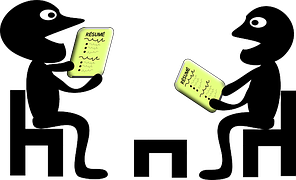
Your body language plays a critical role in shaping the opinion the other people have about you and to some extend the opinion you have for yourself. According to the research done by Amy, among other researchers:
“Power posing affects participants ‘presentation quality during a job interview, which influences judges ‘evaluations’ and hiring decisions. The high-power posers, in contrast to low-power posers, appeared to better maintain their composure, project more confidence, and present more captivating and enthusiastic speeches, in turn leading to higher overall performance evaluations.”
At “High-stake social evaluations”: Stand tall, act with discretion
“High-Stakes social evaluations” are situations like job interviews, sales or boardrooms meetings. These are situations characterized by a “power asymmetry” in the sense that the evaluator has control over your future. By non-verbally manipulating power (high-power posing), you stand a good chance of striking a good rapport with your evaluators (they could be your interviewers). However, the high power posers should appear low-power in relation to the evaluators. Assuming high power poses in job interviews may not go well with some interviewers. You won’t want to come off as offensive, presumptive and rude to your interviewer, regardless of how it made you feel.
What to do:
Before an interview
Are you headed for an interview? Go to the bathroom or a private space and stand for two minutes with your arms overhead and your legs apart, making your body into a large X shape. This expansive pose can cause a spike in testosterone and a drop in cortisol, which can lead to feelings of calm empowerment. This leads to your improved performance during the actual interview. Posing will help you to better prepare for the interview and will help you achieve improved performance.
Before closing a deal
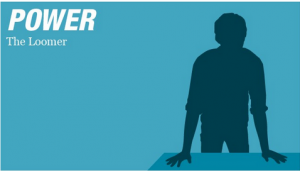 </a>
</a>
Are you a sales executive? Want to close a deal? Plant your hands on the table and lean forward and command the room with a position Amy calls “The Loomer.” Why is it important? When you forward while standing, it shows that you are engaged and in a position of dominance.
Negotiating a pay rise
“The Squinch”, by the photographer Peter Hurley will do you wonders. You just need to pinch your lower eyelids. According to Hurly, “Confidence comes from the eyes, and so does fear.” If you want to send a message that you are nervous, make those wide, deer-in-the-headlights eyes. Otherwise if you to show your boss you know your worth, here is the trick: tighten the palpebral ligament so as to bring the eyelid up. There you are. Enjoy the perks.
Confidence is everything: Whether fake or real.
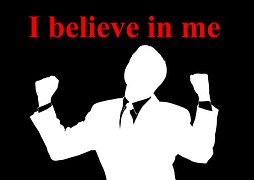 </a>
</a>
Have you seen someone hiding, camouflaging or trying to make their bodies appear too small? When you feel frightened, you will want to make your body small to hide yourself. You can also covering your vulnerable parts –like the neck or, stomach with your hands and your body. These are low-power signals of insecurity. There so many body moves that can signal your insecurity. How can you beat this low-power habit?
Try power posing to portray a sense of confidence
Do you often feel like an imposter? Do you often feel inadequate and unwilling to approach anything that really scares you? Certainly, many of us share such sentiments. And that’s exactly what Amy experienced. She felt inadequate for the tasks that were ahead of her - schooling and job - given her 2% deviation in her IQ after an accident. But her adviser would not let her go. She was advised to” fake it until she makes it.” The results were wonderful. According to her research, power (“power posing”) - even for as little as two minutes – can increase your testosterone by 20% and decrease your cortisol by 20%, increases your appetite for risk, and may cause you to perform better in job interviews. If you act powerfully, you will begin to think powerfully and you will gain confidence. You have to “fake it until you make it.” When people feel personally powerful, they become better connected with their own thoughts and feelings, which help them to better connect with the thoughts and feelings of others.
Indeed, small changes in your body - like a simple power pose - can change your body chemistry. Power pose increases your testosterone levels and lowers the cortisol hormone levels. Thus, it makes you believe that you are in control, you have the dominance and you are the powerful one. Taking a 2 min power pose can go a long way in preparing you mentally and physiologically to endure difficult and stressful situations. Power posing can also help you improve performance in competitive situations. And as Amy advices, even if you feel like a loser, have no energy mental capacity or skill set to achieve a particular goal, adopt the strategy of “fake it till you make it”.
It will finally get you there.
Over a period of time these postural changes could add to your overall health and well-being as well. If you have felt the same way ever and have tried to overcome your feelings of loss of control and self confidence, feel free to share with.

More Posts
12 Productivity Software Tools for Small Businesses
Every small business needs the right tools to stay productive. With countless apps vying for your attention, it can take time to identify which ones offer genuine value. But worry not! We've filtered...
Top Productivity Tracker Tools of 2025 to Boost Efficiency
Are you looking for a reliable productivity tracker to manage your time better and boost efficiency? In this article, we’ll explore the top productivity tracker tools of 2025, outlining their features and how...
15 Lessons Every Entrepreneur Needs To Know
Leaving a corporate world and starting your own business is something everyone of us wants. When our founder, Aymeric started off with [Week Plan,](https://weekplan.net/weekly-planner/) he learned that he can’t learn and be the...
The Best 50 Books to Increase Productivity
Productivity and being gainful can mean various things to various individuals. It will rely upon what you eventually need to achieve. There are in a real sense a huge number of books regarding...